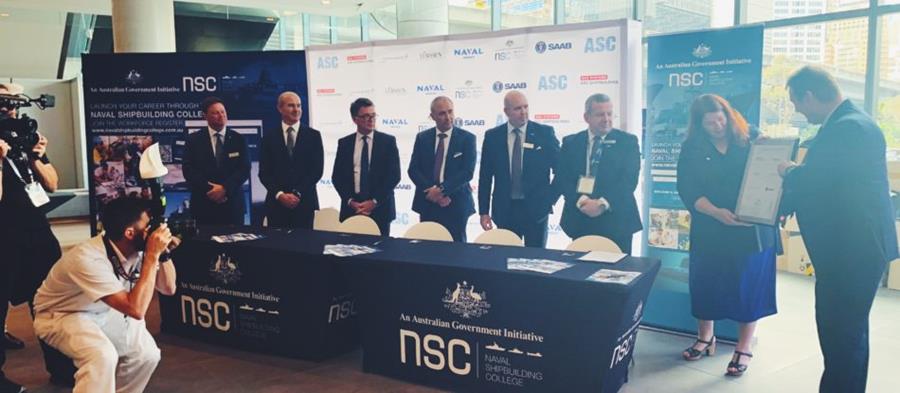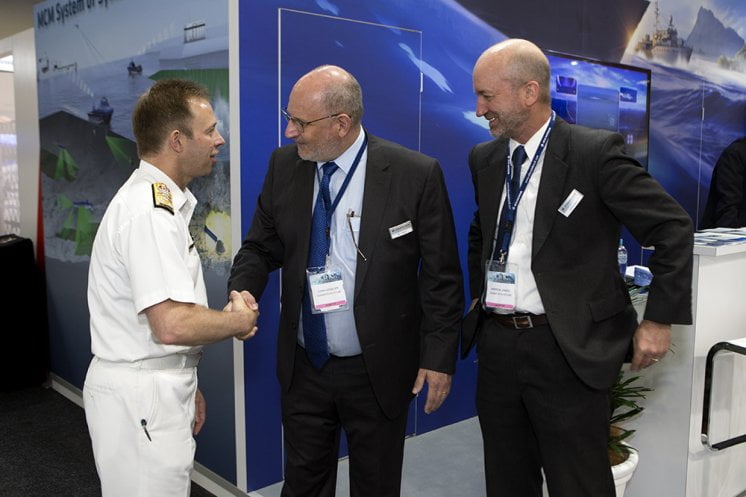By Robbin Laird
As I have argued earlier that the rebuild of the Australian Navy is not just a whole of government effort but a whole of society effort, if it is to succeed.
The Australian Chief of the Navy, Vice Admiral Mike Noonan, emphasized in his presentation in the first session of his seapower conference the importance of various partnerships. Clearly, for the new Navy to emerge, the approach to industry, local and global would need to change.
The strategic goals is toe shape a “continuous shipbuilding approach” which at its heart is about keeping the shipbuilding skill sets in play rather than one offing those skill sets with any build of a particular class of ship.
For this to work, the industrial-navy working relationship needs to be recast to operate throughout various regions of Australia, and with incentivized contracts for industry to be involved throughout the life cycle of any particular class of ship, in its sustainment and modernization.
This is especially significant with the 21st century approach to software upgradeability in the combat and weapons systems, and the strategic focus on shaping not just an integrated navy but a navy within an integrated force.
These goals simply will not be met with the legacy approach of the Australian government to industry.
How to do so is a challenge, for which Australia is in early days of the journey.
CMDR Fenn Kemp in an article published on Australian Navy’s website on October 8, 2019, highlighted the head of Navy’s approach:
The Navy Industry Engagement Strategy was launched by the Chief of Navy at the start of the Sea Power Conference in Sydney.
Vice Admiral Mike Noonan said the Royal Australian Navy was undergoing an unprecedented and ambitious shipbuilding program and Industry is a critical driver of success.
“Without Industry we don’t go to sea, we don’t fly our aircraft and ultimately, we are unable to defend Australia and our national interests,” Chief of Navy said.
“It was really obvious to me that we needed to transform Navy’s transactional relationships with Industry to those of longer-term, mutually beneficial, partnerships,” he said.
The strategy is based on four ‘Ds’ –
- Direction – which must be consistent and aligned
- Dialogue – effective two-way communication between Industry and Navy
- Difference – through innovation
- Delivery – focus on capability
The Chief of Navy has signalled a renewed focus on engaging Defence businesses of all sizes to advance Navy’s capability.
“As Chief of Navy, I’m excited to continue meeting with large and medium enterprises,” Vice Admiral Noonan told the gathering.
“More and more, you’ll see me and my leadership team meeting with small businesses across our country.”
Vice Admiral Noonan said as capability manager and as an end user, Navy is determined to have a voice in all phases of the capability life cycle.
“We have a world class, capable, and lethal Navy,” Vice Admiral Noonan said.
“I need cutting edge technology in all aspects of the Australian shipbuilding Industry,” he said.
And this is how the Navy has described the new approach as well:
It is the Chief of Navy’s intent that the implementation of a Navy Industry Engagement Strategy, one that directly supports Plan Pelorus, will provide an ideal opportunity to regenerate, refocus and ultimately strengthen Navy’s relationship with industry and academia.
This strategy makes it clear that the Chief of Navy is focused on providing a clear direction of where we are going, what our needs are, and why. The Chief of Navy wants industry and academia to understand that what they are producing, no matter how big or how small, contributes to the bigger picture of Navy’s capability, and our national interest.
Together, the naval enterprise, industry and academia have an unprecedented opportunity to contribute to nation building and, in doing so, build a maritime capability that will underpin the long-term security and prosperity of Australia and our region. When we get this right, it will lead to increased opportunities for technology creation, innovation, and exploitation in our country. It will lead to an increase in Australian industry capability and capacity and will involve more Australians and more small businesses as we deliver and sustain leading edge Navy capability.
And on Day 1of PACIFIC 2019 Australia’s leading naval shipbuilding employers have signed a landmark Industry Strategic Workforce Plan that boosts Australia’s capability to continuously design, build, integrate and sustain its naval fleet.
According to the conference press release about this effort:
The Australian Government’s long term strategic plan and $90 billion investment in the nation’s naval shipbuilding industry have been the catalyst for this unprecedented collaboration.
The Plan has been implemented following ongoing collaboration between the Naval Shipbuilding College and five naval shipbuilding Primes – ASC, BAE Systems Australia/ASC Shipbuilding, Lockheed Martin Australia, Luerssen Australia, Naval Group Australia and SAAB Australia.
Chief Executive of the Naval Shipbuilding College Ian Irving said it details the national Naval Shipbuilding Enterprise’s pledge to work together to develop and retain a skilled workforce.
“Industry recognises it is stronger and will be more successful when operating collaboratively, in terms of workforce development in Australia,” Mr Irving said.
“It is very much a case of the whole being greater than the sum of its parts. All the companies involved have skin in the game and are committed to working cooperatively to create a sovereign, naval shipbuilding workforce capability for Australia for generations to come.”
The Plan outlines the commitment of all signatories to develop a cost-effective Australian naval shipbuilding workforce capable of delivering current and future maritime acquisition and sustainment programs, including the Attack Class, Hunter Class and Arafura Class Programs.

Each industry partner continues to provide the Naval Shipbuilding College with workforce demand and skill set data. This will provide industry demand profiles outlining the needs of industry throughout the life of each Program.
As competition in the market continues to intensify the Naval Shipbuilding College and Industry will strengthen their engagement with training and education providers in every state and territory to help promote naval shipbuilding skills growth and assist vocational and tertiary sectors to respond to the rapid pace of changing technology across the industry.
The featured photo shows Chief of Navy, Vice Admiral Mike Noonan AO, RAN, meeting Mr John Gessler and Mr Andrew James from Sonartech Atlas at Sea Power 19.
Industry_Engagement_Strategy_2019_1


